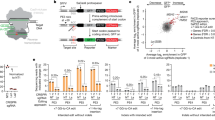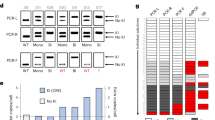Abstract
In Old World primates, TRIM5-α confers a potent block to human immunodeficiency virus type 1 (HIV-1) infection that acts after virus entry into cells1,2,3,4,5. Cyclophilin A (CypA) binding to viral capsid protects HIV-1 from a similar activity in human cells4,6,7,8. Among New World primates, only owl monkeys exhibit post-entry restriction of HIV-1 (ref. 1). Paradoxically, the barrier to HIV-1 in owl monkey cells is released by capsid mutants or drugs that disrupt capsid interaction with CypA4. Here we show that knockdown of owl monkey CypA by RNA interference (RNAi) correlates with suppression of anti-HIV-1 activity. However, reintroduction of CypA protein to RNAi-treated cells did not restore antiviral activity. A search for additional RNAi targets unearthed TRIMCyp, an RNAi-responsive messenger RNA encoding a TRIM5–CypA fusion protein. TRIMCyp accounts for post-entry restriction of HIV-1 in owl monkeys and blocks HIV-1 infection when transferred to otherwise infectable human or rat cells. It seems that TRIMCyp arose after the divergence of New and Old World primates when a LINE-1 retrotransposon catalysed the insertion of a CypA complementary DNA into the TRIM5 locus. This is the first vertebrate example of a chimaeric gene generated by this mechanism of exon shuffling.
This is a preview of subscription content, access via your institution
Access options
Subscribe to this journal
Receive 51 print issues and online access
$199.00 per year
only $3.90 per issue
Buy this article
- Purchase on Springer Link
- Instant access to full article PDF
Prices may be subject to local taxes which are calculated during checkout




Similar content being viewed by others
References
Hofmann, W. et al. Species-specific, postentry barriers to primate immunodeficiency virus infection. J. Virol. 73, 10020–10028 (1999)
Cowan, S. et al. Cellular inhibitors with Fv1-like activity restrict human and simian immunodeficiency virus tropism. Proc. Natl Acad. Sci. USA 99, 11914–11919 (2002)
Besnier, C., Takeuchi, Y. & Towers, G. Restriction of lentivirus in monkeys. Proc. Natl Acad. Sci. USA 99, 11920–11925 (2002)
Towers, G. J. et al. Cyclophilin A modulates the sensitivity of HIV-1 to host restriction factors. Nature Med. 9, 1138–1143 (2003)
Stremlau, M. et al. The cytoplasmic body component TRIM5α restricts HIV-1 infection in Old World monkeys. Nature 427, 848–853 (2004)
Luban, J., Bossolt, K. L., Franke, E. K., Kalpana, G. V. & Goff, S. P. Human immunodeficiency virus type 1 Gag protein binds to cyclophilins A and B. Cell 73, 1067–1078 (1993)
Braaten, D. & Luban, J. Cyclophilin A regulates HIV-1 infectivity, as demonstrated by gene targeting in human T cells. EMBO J. 20, 1300–1309 (2001)
Franke, E. K., Yuan, H. E. & Luban, J. Specific incorporation of cyclophilin A into HIV-1 virions. Nature 372, 359–362 (1994)
Thali, M. et al. Functional association of cyclophilin A with HIV-1 virions. Nature 372, 363–365 (1994)
Fehr, T., Kallen, J., Oberer, L., Sanglier, J. J. & Schilling, W. Sanglifehrins A, B, C and D, novel cyclophilin-binding compounds isolated from Streptomyces sp. A92–308110. II. Structure elucidation, stereochemistry and physico-chemical properties. J. Antibiot. (Tokyo) 52, 474–479 (1999)
Jackson, A. L. et al. Expression profiling reveals off-target gene regulation by RNAi. Nature Biotechnol. 21, 635–637 (2003)
Kazazian, H. H. Jr Mobile elements: drivers of genome evolution. Science 303, 1626–1632 (2004)
Feng, Q., Moran, J. V., Kazazian, H. H. Jr & Boeke, J. D. Human L1 retrotransposon encodes a conserved endonuclease required for retrotransposition. Cell 87, 905–916 (1996)
Zhang, Z., Harrison, P. M., Liu, Y. & Gerstein, M. Millions of years of evolution preserved: a comprehensive catalog of the processed pseudogenes in the human genome. Genome Res. 13, 2541–2558 (2003)
Xu, L. et al. BTBD1 and BTBD2 colocalize to cytoplasmic bodies with the RBCC/tripartite motif protein, TRIM5δ. Exp. Cell Res. 288, 84–93 (2003)
Schwartz, O., Marechal, V., Friguet, B., Arenzana-Seisdedos, F. & Heard, J. M. Antiviral activity of the proteasome on incoming human immunodeficiency virus type 1. J. Virol. 72, 3845–3850 (1998)
Reymond, A. et al. The tripartite motif family identifies cell compartments. EMBO J. 20, 2140–2151 (2001)
Wu, J., Matunis, M. J., Kraemer, D., Blobel, G. & Coutavas, E. Nup358, a cytoplasmically exposed nucleoporin with peptide repeats, Ran-GTP binding sites, zinc fingers, a cyclophilin A homologous domain, and a leucine-rich region. J. Biol. Chem. 270, 14209–14213 (1995)
McClintock, B. The origin and behavior of mutable loci in maize. Proc. Natl Acad. Sci. USA 36, 344–355 (1950)
Esnault, C., Maestre, J. & Heidmann, T. Human LINE retrotransposons generate processed pseudogenes. Nature Genet. 24, 363–367 (2000)
Wei, W. et al. Human L1 retrotransposition: cis preference versus trans complementation. Mol. Cell. Biol. 21, 1429–1439 (2001)
Dewannieux, M., Esnault, C. & Heidmann, T. LINE-mediated retrotransposition of marked Alu sequences. Nature Genet. 35, 41–48 (2003)
Gilbert, W. Why genes in pieces? Nature 271, 501 (1978)
Moran, J. V., DeBerardinis, R. J. & Kazazian, H. H. Jr Exon shuffling by L1 retrotransposition. Science 283, 1530–1534 (1999)
Damert, A., Lower, J. & Lower, R. Leptin receptor isoform 219.1: an example of protein evolution by LINE-1-mediated human-specific retrotransposition of a coding SVA element. Mol. Biol. Evol. 21, 647–651 (2004)
Ejima, Y. & Yang, L. Trans mobilization of genomic DNA as a mechanism for retrotransposon-mediated exon shuffling. Hum. Mol. Genet. 12, 1321–1328 (2003)
Long, M. & Langley, C. H. Natural selection and the origin of jingwei, a chimeric processed functional gene in Drosophila. Science 260, 91–95 (1993)
Roy-Engel, A. M. et al. Non-traditional Alu evolution and primate genomic diversity. J. Mol. Biol. 316, 1033–1040 (2002)
Brummelkamp, T. R., Bernards, R. & Agami, R. A system for stable expression of short interfering RNAs in mammalian cells. Science 296, 550–553 (2002)
Asmal, M. et al. Production of ribosome components in effector CD4 + T cells is accelerated by TCR stimulation and coordinated by ERK-MAPK. Immunity 19, 535–548 (2003)
Acknowledgements
We thank P. Bieniasz, S. Goff, M. Nicolelis, E. Phelps, S. Ribeiro, G. Towers and S. Valente for reagents. This work was supported by the NIH (J.L.), the Medical Scientist Training Program (D.M.S.), and AmFAR (L.B.).
Author information
Authors and Affiliations
Corresponding author
Ethics declarations
Competing interests
The authors declare that they have no competing financial interests.
Supplementary information
Rights and permissions
About this article
Cite this article
Sayah, D., Sokolskaja, E., Berthoux, L. et al. Cyclophilin A retrotransposition into TRIM5 explains owl monkey resistance to HIV-1. Nature 430, 569–573 (2004). https://doi.org/10.1038/nature02777
Received:
Accepted:
Published:
Issue Date:
DOI: https://doi.org/10.1038/nature02777
This article is cited by
-
TRIM5α recruits HDAC1 to p50 and Sp1 and promotes H3K9 deacetylation at the HIV-1 LTR
Nature Communications (2023)
-
Evolutionary honing in and mutational replacement: how long-term directed mutational responses to specific environmental pressures are possible
Theory in Biosciences (2023)
-
Genes that are Used Together are More Likely to be Fused Together in Evolution by Mutational Mechanisms: A Bioinformatic Test of the Used-Fused Hypothesis
Evolutionary Biology (2023)
-
The coevolution between APOBEC3 and retrotransposons in primates
Mobile DNA (2022)
-
Identification of 2-(4-N,N-Dimethylaminophenyl)-5-methyl-1-phenethyl-1H-benzimidazole targeting HIV-1 CA capsid protein and inhibiting HIV-1 replication in cellulo
BMC Pharmacology and Toxicology (2022)
Comments
By submitting a comment you agree to abide by our Terms and Community Guidelines. If you find something abusive or that does not comply with our terms or guidelines please flag it as inappropriate.



